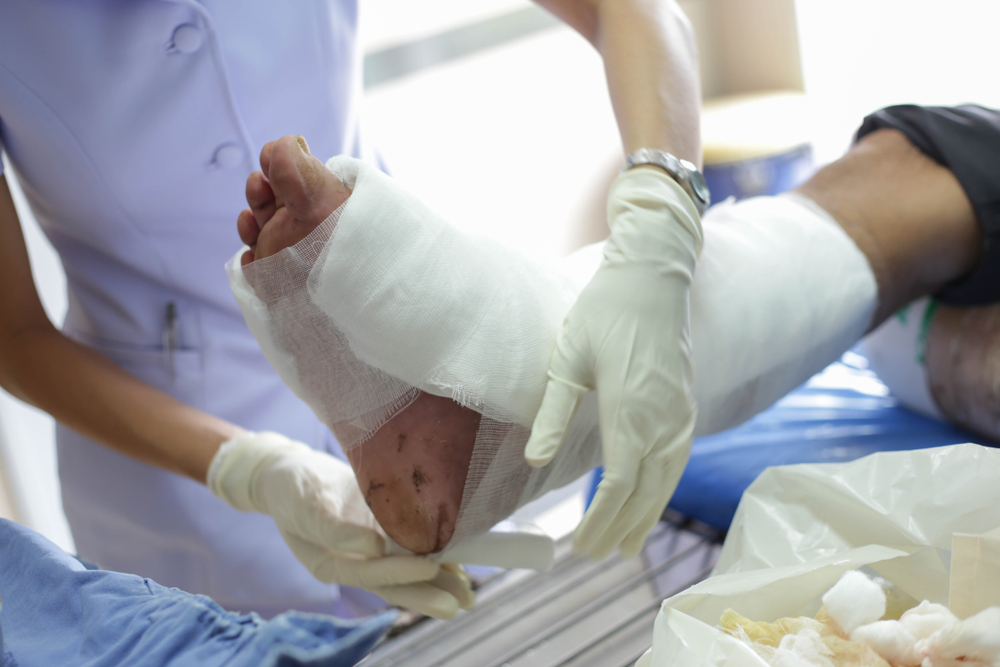When patients have been diagnosed with diabetes, one common complication that they should be aware of is the potential for developing nonhealing wounds, particularly on the feet. Diabetes puts patients at risk for conditions that, when taken together, make it more likely for them to suffer minor injuries without noticing, which then fail to get better. Treatment for diabetic foot ulcers typically focuses first on prevention, and then on wound care techniques meant to prevent these injuries from leading to catastrophic consequences like an amputation. However, it is becoming increasingly evident that interventional radiology can help promote the healing of chronic diabetic wounds by restoring blood flow to the tissue where circulation is poor.
What Causes Diabetic Foot Ulcers
To understand the role that an expert interventional radiologist can play in preventing the worst complications of diabetic foot disease, it’s essential to understand the underlying mechanisms that lead to chronic foot ulcers. High blood sugar, especially when it is poorly controlled, affects the nervous system, the immune system, and the circulatory system.
First, diabetic patients are at risk for developing peripheral neuropathy, a condition that damages the nerves. This causes tingling, pain, and/or numbness in the limbs. Those affected may not feel when they develop a blister from a poorly fitting shoe or when an ingrown toenail has become infected. While this kind of minor wound wouldn’t be a problem for someone without an underlying health condition, for diabetics it should be treated promptly, because diabetes also interferes with the normal functioning of the immune system. While the exact mechanisms are still being studied, it is clear that diabetes makes it harder to fight off infection and increases inflammation, both of which make it harder for wounds to heal properly.
Finally, diabetes is a risk factor for developing peripheral artery disease (PAD). In this progressive condition, arteries are narrowed or blocked by fatty plaques, restricting normal circulation. While PAD can affect blood vessels throughout the body, it most commonly impacts the legs and feet. Constricted blood flow makes it even harder to fight infection and heal chronic wounds, increasing the likelihood that more serious surgical interventions will be necessary to prevent the wound from becoming life-threatening.
How Interventional Radiology Can Help
Procedures to restore blood flow to the legs and feet can form a critical part of a comprehensive care plan to promote healing in diabetic foot ulcers that have lingered for weeks or months without significant improvement. Diagnostic imaging can help identify blood vessels that are narrowed or blocked. Then, affected arteries can be opened with a catheter and balloon, or in some cases a stent, which increases blood flow and facilitates healing. Most importantly, interventional radiological techniques are minimally invasive and performed on an outpatient basis, which allows patients to get the help they need without hospital stays or a prolonged recovery period.
Peripheral artery disease can be difficult to diagnose, as classic symptoms like leg cramps may be attributed to other causes. For patients who have been undergoing wound care treatment for diabetic foot ulcers without success in healing, an evaluation by an experienced interventional radiologist may be a matter of urgency by the time they realize traditional approaches are not enough on their own. At the Vein and Fibroid Treatment Center, we’re experienced in providing timely, expert care to restore blood flow and promote recovery from stubborn diabetic wounds.
Dr. Omar Saleh, a board-certified interventional radiologist, works with patients suffering from circulation issues and their medical providers to identify problems with impaired blood flow and devise an effective treatment plan. His practice is devoted to providing minimally invasive treatments that get patients back to health and the activities they love without major surgery. Our offices in Corona and Colton are conveniently located for patients in the Inland Empire and surrounding areas of Southern California.
Advanced Treatment for Chronic Diabetic Wounds
If you’re a diabetic patient with a chronic wound, don’t wait until you’ve run out of options. The Vein and Fibroid Treatment Center may be able to provide the care you need to heal. To schedule your initial consultation, contact us here.




